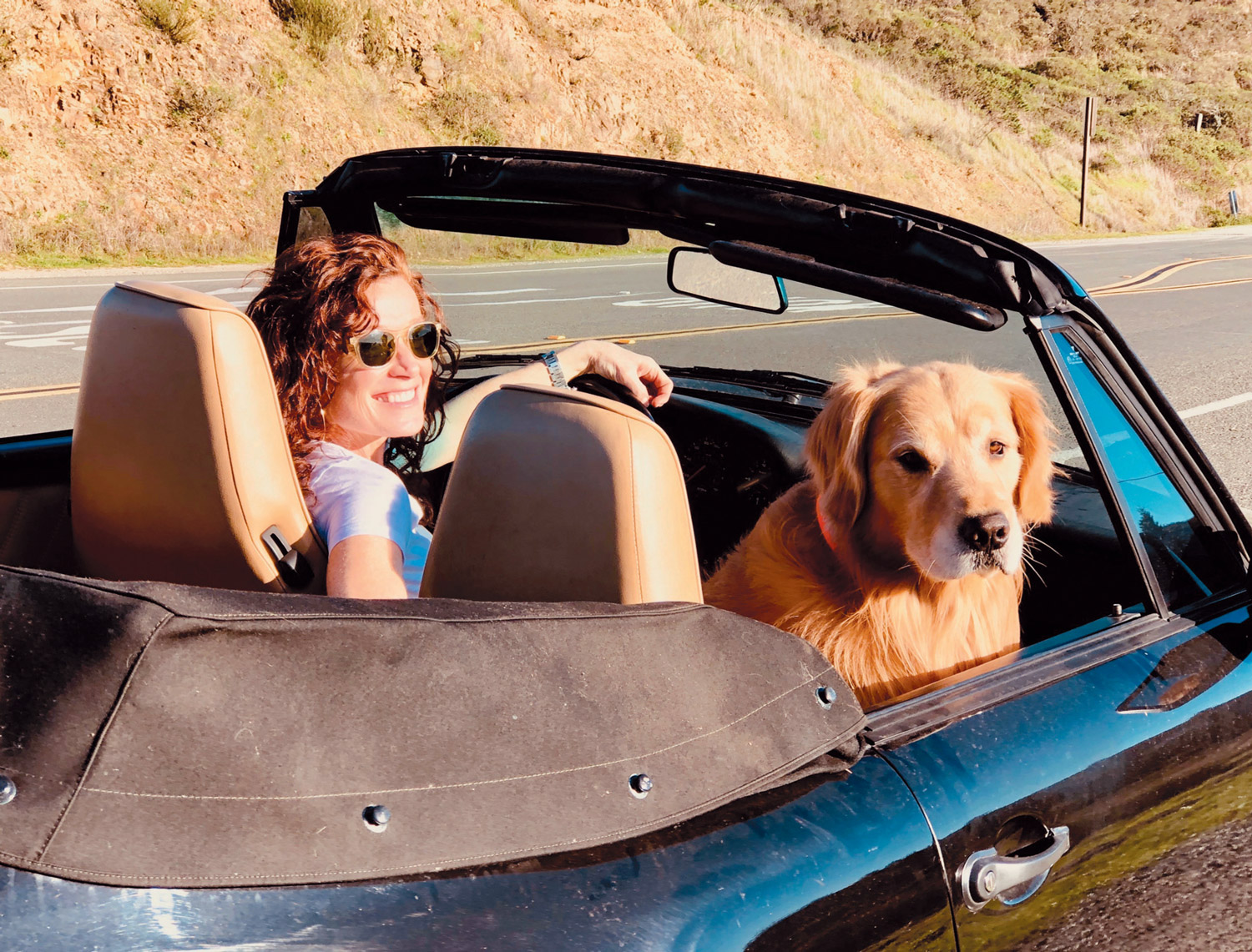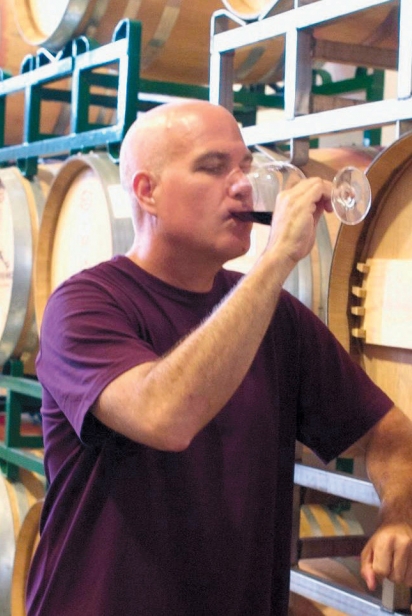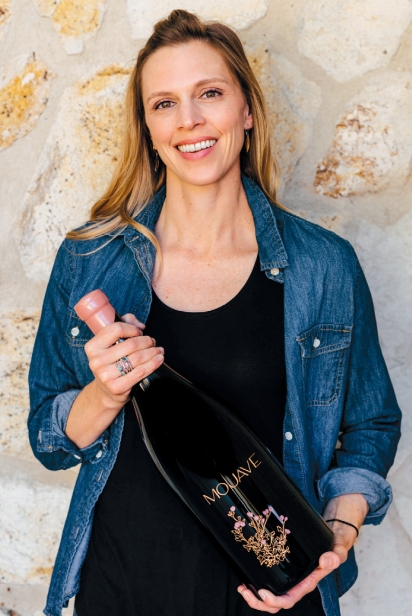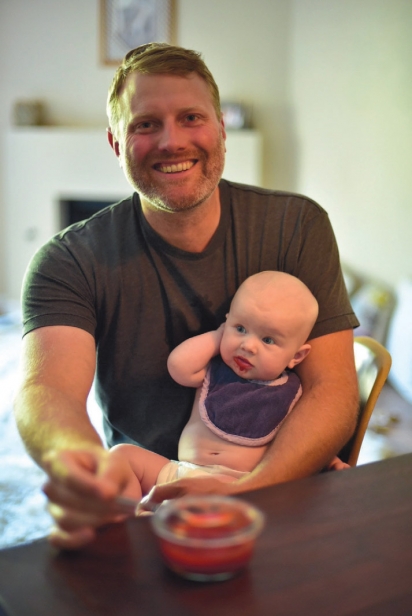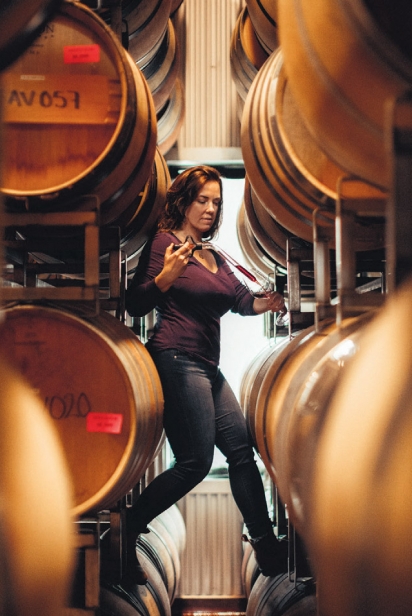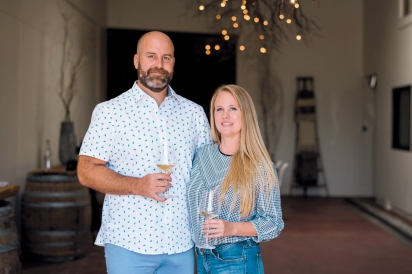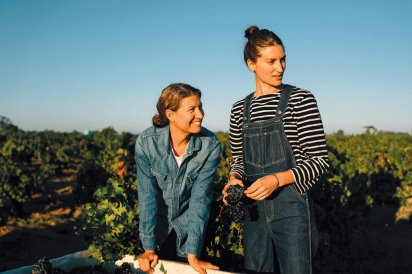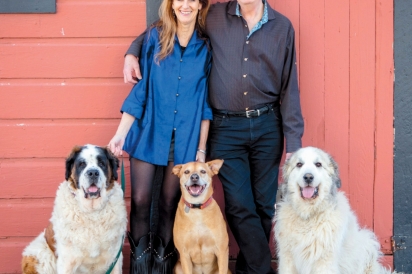Wine-Sight
CHECKING BACK IN WITH A FEW “UP AND COMING” WINEMAKERS
She killed the ignition on her black 1991 Porsche Carrera, silencing the Bay Area’s own Patrick Monahan as he crooned “Hey soul sister, ain’t that Mr. Mister on the radio…” and experienced her first moment of silence in what felt like a very long time. Earlier that day, a dream had come true for Gibson Thomas, publisher and editor-in-chief of Edible Marin & Wine Country.
Thomas, a native of the South and an attorney by trade, had not all that long ago been running a catering company in Washington, DC. Her heart had always been in the food world far more than in law. Food brought people together; the law, oft en, tore them apart.
Soon after moving to the Bay Area in 1998 she read an article by Patricia Unterman in The San Francisco Chronicle about the Slow Food movement, felt something light up inside of her and immediately joined the local chapter. Little did she know how this simple act would come to change her life.
A few years later, while in the Hamptons, NY, for a friend’s wedding, she encountered her first Edible publication, Edible East End. She devoured every article. Six months later, the mother of a friend she visited in Santa Fe, NM, knowing of her interest in food, placed a copy of Edible Santa Fe in her guestroom. Seeking out and experiencing the food and drink producers featured in the magazine became the focus of the trip.
Still serving as general counsel for a private equity fund, it wasn’t until the Slow Food Nation gathering in San Francisco over the 2008 Labor Day weekend where she met a couple of fellow Slow Food leaders from around the U.S. who also published the Edible magazines for their regions, that the light bulb fully clicked on.
Thomas purchased the license to found and publish the Edible magazine covering Marin, Napa and Sonoma counties six weeks later, inspired by a calling to celebrate her superstars—the producers of local food and drink in the region—and to build community around a table.
That mid-May evening in 2009 when she parked her vintage ragtop outside a friend’s house to start the celebration that would end up at Oakland’s Fox Theatre, listening to fellow Southerners The Allman Brothers Band, she had just sent her premiere issue to the printer. Thomas knew she had just set out on the journey of a lifetime, but she could not have foretold how much her own personal quest would affect the lives of many others in Marin and Wine Country.
Thomas was aware of the conventional wisdom, of course: In the digital age, the market for print was waning. But she believed that the people who care about the food they eat and feed to their family and friends, who produces it and how it is produced, also have a deep appreciation for quality craftsmanship in other areas of their lives, and she was determined to create a quality product. There would certainly be no lack of material to cover in Marin, Napa and Sonoma counties, a foodshed uniquely rich with extraordinary food and drink producers.
She also knew that she knew nothing about publishing a magazine. In those early days, she relied heavily on the community of other Edible publishers across the U.S. and in Canada for guidance, and reached out to the local community for contributors.
First on the scene to write about local wine producers was a husband-wife team Monica and David Stevens. Owners of one of the most respected wine shops in the Napa Valley, St. Helena’s 750 Wines, the Stevenses were a natural fit and enjoyed sharing their passion with Edible Marin & Wine Country readers.
“We like them—they’re our friends,” responded Monica when asked what initially made her want to write about winemakers. “Wine is wine. It’s the people that we love, and when you know these people you love to talk about them.” The Stevenses shined a spotlight on some truly talented “up and coming” winemakers, those who would have to carry the torch as the founders of Northern California’s Wine Country aged, or sold, out.
The next 10 years would be a tumultuous spell for Wine Country. A cranky, sweeping generalization by a popular wine critic would send the industry into a frenzy over the 2011 vintage in a nearly unprecedented manner. Wildfires and planned power outages would threaten the life of the lush valleys and those who live in them. Local politicians would come and go. But more than anything, and despite or perhaps even in part because of the struggle, there was phenomenal growth.
Between 2011 and 2016, Forbes estimates that the number of wineries in California jumped by 31%. According to ABC News, since 2015, 170 new wineries are registered each year in the Napa Valley alone. Discover California Wines estimates that there are currently 3,900 bonded wineries in the state of California, excluding second tasting rooms. Other estimates put this number above 4,500.
Amongst the masses, then, it takes not only immense talent and lots of hard work but also a bit of luck to rise to the top. Part of that luck is having your story told by respected members of the wine community, like Monica and David Stevens. Ten years later we wanted to check in on a handful of those “up and comers,” to see just how far they have risen.
MEGAN AND RYAN GLAAB
Two of the young winemakers that the Stevenses highlighted early on were Megan and Ryan Glaab. At the time, Ryan was an assistant winemaker at Pax Mahle Wines, and he and Megan made their own wine on the side. When asked what they were doing 10 years ago, Megan responded, “We were on the hunt for Vermentino and getting ready to bottle our first years of Aglianico and Ribolla Gialla.” The couple’s passion for lesser-utilized varietals would soon pay off .
They opened the Forestville tasting room for their own Ryme Cellars wines in 2015, and in 2017 launched a second label, Uphold Wines, a value-oriented brand from which the profits are donated to support social and environmental equality.
“In the last 10 years California wine has seen an explosion of diversity,” said Megan. “There is a dynamic array of wine styles and grape varieties now that would have been cautioned as unviable 10 years ago. This has been largely driven by young consumers with an interest in experimentation and openness to new experiences.”
ROY PIPER
“Ten years ago, the first time I appeared in Edible Marin & Wine Country, I was assistant winemaker at Seven Stones Winery under Aaron Pott, one of the best consulting winemakers in the Valley. Wow, time flies!” recalled Roy Piper. Having quit work at America’s largest insurance company to—not unlike so many before him— chase a dream of making wine in Napa, he had started out as a “cellar rat” at Quintessa, quickly working his way up. “I had an itch I had to scratch.”
“I founded my own winery, Roy Piper Wines, the year following that interview. When I first left finance and entered the wine industry in 2005, having my own winery was always the goal. I feel lucky to be living that dream,” Piper continued. Currently Piper makes one wine, a Cabernet Sauvignon, from grapes sourced from Mt. Veeder and Pritchard Hill.
Perhaps equally, if not more, exciting than founding his own successful wine brand, Piper also shared: “I got married for the first time in 2017! At age 50, to boot!” He and his wife met over 20 years ago, at a wine shop in Southern California, but they didn’t realize this until far more recently, when they were already seriously dating. Reflects the man who left finance for the wine world back in 2005, “It’s interesting how some things turn out.”
BECKY GEORGE
Ten years ago, Becky George was just concluding a three-year stint as assistant winemaker at Schramsberg, the second-oldest winery in the Napa Valley, and working harvest for Marcassin Vineyards in Sonoma. That same year, she started working for Kelly Fleming Wines, a small 11-acre estate and winery in a quiet canyon near Calistoga. Today, George is the winemaker there.
“Because of the smaller size, I’ve been able to stay close to the vines and the wines, and dive into what makes this property great. After almost 10 years I have a great grasp on the property and the characters of the wines from each vineyard plot, and how they can come together in a blend,” said George.
In addition, Fleming allows George to make wines under her own label, Mojave Wines, on site. “I grew up in eastern California’s Mojave Desert and spent much of my adolescence exploring petroglyph-lined canyons and trekking through wildflower-dense landscapes,” George writes on her winery’s web page, regarding the origin of the name. The wines are Pinot Noir, perhaps a nod to her time spent in Burgundy, and are crafted from fruit harvested from the cool climes of the Anderson Valley AVA and the Santa Cruz Mountains AVA.
When asked about the changes she’s seen during her time in Wine Country, George became reflective. “One of the biggest changes I’ve seen … is how climate change has affected grape growing and winemaking.” It’s a topic many in the industry, for many reasons, are unwilling to dive into. George doesn’t hesitate. “The fires started in earnest in 2015 and have progressively gotten worse over the past four years,” she said. “[During] harvest, winemaking gets infinitely more challenging when you have to (a) evacuate the winery because you’re in a fire zone, (b) deal with smoke-tainted grapes even though the fire is in a different county or (c) rely on a constantly running generator during the power shutdowns. Beyond the fires, the weather each season is getting more unpredictable, and warmer temps are forcing everyone to reassess vineyard plans for the future.”
Over the years she’s been at Kelly Fleming Wine, George’s Cabernet Sauvignon in particular has garnered high scores from critics. In 2019, Antonio Galloni named Becky George “Emerging Winemaker of the Year,” a high honor and one a long time in the making. “I guess I’ve been emerging for about 10 years,” quipped George.
KellyFlemingWines • MojaveWines.com
MICHELE OUELLET AND MINDY KEARNEY
Michele Ouellet and her mother, Melinda “Mindy” Kearney, had set out to have a good time, to bond with one another and to create what Michele termed a “little pet project” by making a rosé wine out of their shared love of the style. The pair didn’t yet realize, 10 years ago, that Lorenza Rosé was about to become a national sensation and a fulltime job. At the time, they were getting ready to bottle their third vintage and experimenting with different looks for labels to apply to the fewer than 1,000 cases they were then producing.
Fast forward to today, and Lorenza Rosé has been named the number one rosé by the Wall Street Journal, and is featured on wine lists from Napa’s three-Michelin-starred The French Laundry to New York’s Eleven Madison Park to American Airlines Flagship lounges. “Lorenza Rosé is a female-founded, women-owned winery focusing on dry true rosé made from old vines,” related the mother-daughter team, with the sort of pride in their achievement that one might expect from people who had created a successful business using passion as the primary ingredient.
Pale, delicate, dry and low in alcohol, and all by design, Lorenza Rosé is more Old World in style than most of the pink concoctions being bottled up and down the coast these days. In addition, it’s vegan, gluten free [not all wines are, you might be surprised to learn] and low alcohol, all of which help to make it as accessible as possible to a wine-drinking culture that, until recently, was on the fence about this style of wine. “From the perspective of a rosé producer, over the past 10 years we’ve seen the space grow from a handful of rosé producers to literally countless brands,” noted Ouellet. “Some have already come and gone … Just 10 years ago we were convincing buyers and consumers alike that taking a taste of rosé wasn’t going to be an unpleasant experience. There is still work to do, but luckily rosé has made its way into the zeitgeist.”
SHAWN JOHNSON
“I was learning the craft of winemaking when I was first featured in Edible Marin & Wine Country,” said Shawn Johnson. Then he added, “To be true … the learning never ends.” Whatever learning curve there may have been, it looks as if Johnson has used his time well and learned a great deal in the process.
Johnson is now a well-respected member of Napa’s next generation of vintners. Having studied under winemaking legend Philippe Melka, Johnson now serves as head winemaker for Tuck Beckstoffer Estate.
At Tuck Beckstoffer, Johnson and his team make Chardonnay, Sauvignon Blanc, Cabernet Sauvignon, Grenache and Pinot Noir, as well as several blends and a wildly popular rosé. Johnson reported working with Beckstoffer “an incredible opportunity.” In addition to heading up Beckstoffer’s team, Johnson has founded his own label, Altar, focusing on an array of varietals and AVAs ranging from Napa Cab to Sonoma Coast Chardonnay, and spanning into Lake and Mendocino Counties.
But Johnson has a vision for the future of Wine Country that goes well beyond what he can put in barrel this year. “We’re in the process of making the vineyard completely organic and the [Tuck Beckstoffer] winery Napa Green certified. I’m also involved in the Environmental Stewardship Committee offered by the Napa Valley Vintners.” Perhaps having recently become a father plays a part in his desire to see the Napa Valley preserved long after he has gone.
TuckBeckstoffer.com • DrinkAltar.com
JESSICA TARPY
“Wine is a collaboration, and every step in the process commands respect and diligence,” responded Jessica Tarpy when asked about the most important thing she has learned over the ensuing years since she first appeared in Edible Marin & Wine Country’s 5th Anniversary “Southerners Only”-themed issue. Tarpy has collaborated with renown viticulturalist Annie Favia and Favia’s husband, famed winemaker Andy Erickson, for many years, on many projects. “Working together has fostered a wonderful creative energy,” she noted, and the fruits of that energy are indeed bountiful.
Tarpy cut her teeth and honed her skills at Favia, adding additional labels over the ensuing years. Carbone, ROOM, Ellman and Seven Apart are all collaborative projects based in Napa. Gather and Casino Mine Ranch wines are both personal wine projects, based in Amador County.
Casino Mine Ranch focuses on varietals that are perhaps less common in some regions, but staples of others. Vermentino and Grenache Blanc highlight the whites, while Mourvedre (often used as a blending grape) is featured as a single-varietal wine, alongside Tempranillo and other reds. Gather, similarly, produces a wine that is 91% Tempranillo, 9% Graciano. It may be rare in America for this varietal to get 18 months on French oak, but Tarpy treats it with the care that is often accorded Cabernet Sauvignon, producing only 144 cases. She also crafts a rosé that is 100% Tempranillo.
When asked what she hoped for the next 10 years, Tarpy replied: “[That] there is a focused effort on preserving the land and sustaining production for years to come. I think we owe it to our past and future generations to be the best we can be to make conservation a reality and part of our daily efforts on a large and small scale.”
DAVID AND MONICA STEVENS
As for David and Monica Stevens, the husband-wife team who brought the stories of these, and many other, “up and coming” wine producers to our readers through their stories in Edible Marin & Wine Country, they’ve taken a step back from writing to focus on other projects.
Their expertly curated St. Helena wine shop and tasting room, 750 Wines, continues to thrive, and in 2014 the duo took a leap of faith and founded Jameson Animal Rescue Ranch ( JARR), a no-kill rescue and sanctuary for companion and farm animals in need. The nonprofit provides transitional and permanent shelter, adoption and rescue services, humane education and animal advocacy. JARR also collaborates with and acts as a liaison for various other local animal rescue groups.
“It’s something I always wanted to do since I was a little girl, saving animals,” said Monica Stevens, who prefers to think of the project less as a “rescue center” and more as a “solution center.” She and David both stressed how incredibly grateful they are for the support they have received since founding JARR that has enabled the organization to move from a simple rescue facility to a policy-affecting organization that considers how animals, the environment and human communities are all interconnected. Their work includes providing assistance to low income seniors so they are able to maintain their pets, spay and neuter support for low income pet owners and the enactment of no-kill legislation that impacts communities well beyond Wine Country.
“We wouldn’t be here today, wouldn’t have founded JARR, if it wasn’t for the wine industry,” said Monica. “The wine industry supports us; people support JARR because they get to be around great people and because they love the cause. We’re in the most magical place in the United States.” she added.
This wine industry support is abundantly apparent at JARR’s annual fundraiser, WineaPAWlooza, a wine industry star-studded weekend of events that began in 2014. Monies raised through WineaPAWlooza and other donations to JARR enabled the organization to purchase a 4-acre parcel of land in 2018, and they are currently conducting a capital campaign to raise funds to construct JARR’s Ranch, Solutions and Education Center. This year’s event will be held July 24 & 25.
EDIBLE MARIN & WINE COUNTRY
By almost any standard, the past 10 years have been nothing short of amazing in Northern California’s beautiful and storied Wine Country. The coming 10 will be crucial to its long-term prosperity, and, perhaps, even its survival. As for Gibson Thomas, she’s proud of how far Edible Marin & Wine Country has come, the lives and businesses it has positively affected, and she’s excited for the future.
“Publishing Edible Marin & Wine Country has changed my life,” said Thomas recently. “It has provided me with an incredible community here on the Left Coast, so far from family. It has given me the opportunity to make a real, tangible difference in the world.”
And, yes, she still has the vintage Porsche—perfect for cruising up and down the Napa and Sonoma Valleys, visiting her favorite kind of folks: those who produce good food and good drink.


